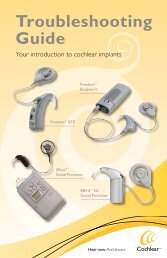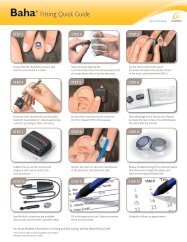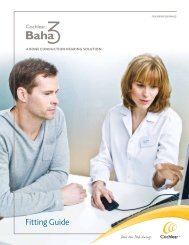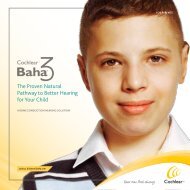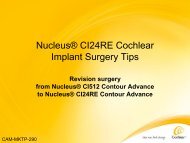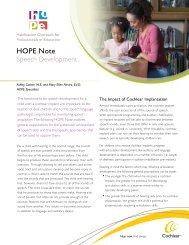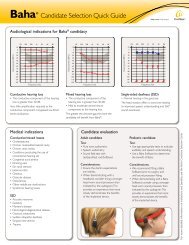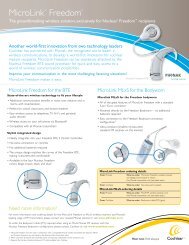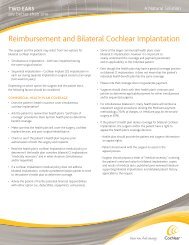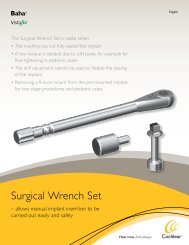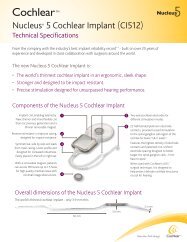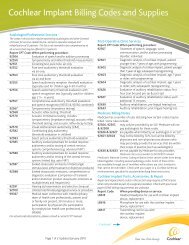Leading the Industry in Cochlear Implant Reliability
Leading the Industry in Cochlear Implant Reliability
Leading the Industry in Cochlear Implant Reliability
You also want an ePaper? Increase the reach of your titles
YUMPU automatically turns print PDFs into web optimized ePapers that Google loves.
Nucleus ® <strong>Reliability</strong> Report Volume 6 | June 2010<br />
<strong>Lead<strong>in</strong>g</strong> <strong>the</strong> <strong>Industry</strong> <strong>in</strong><br />
<strong>Cochlear</strong> <strong>Implant</strong> <strong>Reliability</strong><br />
The <strong>Cochlear</strong> Nucleus ® CI512<br />
<strong>Cochlear</strong> <strong>Implant</strong>
Nucleus ® implant reliability<br />
At <strong>Cochlear</strong> , we take implant reliability seriously. S<strong>in</strong>ce launch<strong>in</strong>g <strong>the</strong><br />
world’s first cochlear implant system <strong>in</strong> 1982, each successive release of<br />
our Nucleus <strong>Cochlear</strong> <strong>Implant</strong> has been more reliable than <strong>the</strong> last. Now<br />
our latest generation implant - <strong>the</strong> Nucleus CI512 - cont<strong>in</strong>ues this legacy<br />
<strong>in</strong> implant reliability. As of June 1, 2010 <strong>the</strong> Nucleus CI512 has achieved<br />
a 100% cumulative survival rate.<br />
Cumulative Failure % of <strong>Implant</strong>s<br />
10<br />
9<br />
8<br />
7<br />
6<br />
5<br />
4<br />
3<br />
2<br />
1<br />
0<br />
Nucleus <strong>Implant</strong>s <strong>Reliability</strong><br />
Cumulative Failure % of <strong>Implant</strong>s<br />
Nucleus CI512 <strong>Reliability</strong><br />
1.5<br />
1.0<br />
0.5<br />
0.0<br />
CI512<br />
1 2 3 4 5 6<br />
Time <strong>in</strong> Years<br />
CI512<br />
1 2 3 4 5 6 7 8 9 10 11 12 13 14 15 16 17 18 19 20 21 22 23<br />
ALL PATIENTS COMBINED AS OF 1 JUNE 2010<br />
2 | Nucleus® <strong>Reliability</strong> Report | June 2010 |<br />
CI24RE<br />
CI24RE<br />
CI22M CI24M (ALL) CI24M (POST) CI24R CI24RE CI512<br />
Cumulative Survival<br />
Percentage (CSP)<br />
YEAR 1<br />
CI512 Adult 100<br />
CI512 Child 100<br />
CI24R<br />
Time <strong>in</strong> Years<br />
CI24M (POST)<br />
CI24M (ALL)<br />
CI22M<br />
Registered <strong>Implant</strong>s as of 1 June 2010<br />
DEvicE ADult chilD totAl<br />
CI512 3,652 3,334 6,986<br />
CI24RE 26,065 29,670 55,735<br />
CI24R 17,573 28,452 46,025<br />
CI24M (All) 7,632 11,638 19,270<br />
CI22M 9,956 8,220 18,176<br />
Cumulative Survival Percentage (CSP)<br />
3 | Nucleus® <strong>Reliability</strong> Report | June 2010 |<br />
20<br />
CI512 <strong>Reliability</strong><br />
YEAR 1 2 3 4 5 6 7 8 9 10 11 12 13 14 15 16 17 18 CI512 19ADULT 20 21 CI512 22 CHILD 23<br />
100<br />
CI22M 99.2 98.6 98.2 97.7 97.5 97.2 96.9 96.7 96.4 96.2 96.0 95.7 95.5 95.2 94.9 94.7 94.5 94.2 93.9 93.7 93.2 92.9 92.9<br />
CI24M (All) 99.5 98.9 98.5 98.3 98.1 97.9 97.8 97.7 97.5 97.4 97.3 97.2 97.0 97.0 - - - - - - - - -<br />
CI24M (Post) 99.5 99.1 98.8 98.6 98.4 98.3 98.1 98.0 97.9 97.88097.7 97.6 - - - - - - - - - - -<br />
Cumulative Survival % of <strong>Implant</strong>s<br />
CI24R 99.7 99.5 99.2 99.1 98.9 98.7 98.6 98.4 98.4 98.4 - - - - - - - - - - - - -<br />
CI24RE 99.7 99.6 99.4 99.3 99.2 99.2 - - - - - - - - - - - - - - - - -<br />
CI512 100 * - - - - - - - - - 60 - - - - - - - - - - - - -<br />
The Cumulative Survival Percentage (CSP) is <strong>the</strong> cumulative number of function<strong>in</strong>g implants over time and can be used<br />
to predict <strong>the</strong> reliability of <strong>the</strong> device with<strong>in</strong> a given time period.<br />
40<br />
Cumulative Failure Percentage (CFP)<br />
YEAR 1 2 3 4 5 6 7 8 9 10 11 12 13 14 15 16 17 18 19 20 21 22 23<br />
CI22M 0.8 1.4 1.8 2.3 2.5 2.8 3.1 3.3 3.6 3.8 4.0 4.3 4.5 4.8CI512 5.1ADULT 5.3 5.5 5.8CI512 6.1CHILD 6.3 6.8 7.1 7.1<br />
CI24M (All) 0.5 1.1 1.5 1.7 1.9 2.1 2.2 2.3 2.5 2.6<br />
0<br />
2.7 2.8 3.0 3.0 - - - 1* - - - - - -<br />
CI24M (Post) 0.5 0.9 1.2 1.4 1.6 1.7 1.9 2.0 2.1 2.2 2.3 2.4 - - - -Time - <strong>in</strong> Years - - - - - -<br />
CI24R 0.3 0.5 0.8 0.9 1.1 1.3 1.4 1.6 1.6 1.6 -ALL PATIENTS - - COMBINED - - -AS OF - 1 JUNE - 2010 - - - - -<br />
CI24RE 0.3 0.4 0.6 0.7 0.8 0.8 - - - - - - - - - - - - - - - - -<br />
CI512 0.0* - - - - - - - - - - - - - - - - - - - - - -<br />
The Cumulative Failure Percentage (CFP) is <strong>the</strong> percentage of devices that are no longer function<strong>in</strong>g after a<br />
given period of time.<br />
* With<strong>in</strong> 1 year
Commitment to cont<strong>in</strong>uous improvement<br />
Over 25 years, <strong>Cochlear</strong> has released five<br />
generations of implants with <strong>the</strong> most recent be<strong>in</strong>g<br />
<strong>the</strong> Nucleus ® CI512 <strong>Cochlear</strong> <strong>Implant</strong>. Follow<strong>in</strong>g<br />
best practice <strong>in</strong> design processes <strong>Cochlear</strong> has<br />
applied <strong>the</strong> pr<strong>in</strong>ciples of cont<strong>in</strong>uous improvement<br />
<strong>in</strong> <strong>the</strong> design and development of <strong>the</strong>se implant<br />
platforms. This philosophy of cont<strong>in</strong>uous<br />
improvement has resulted <strong>in</strong> each generation<br />
of implant be<strong>in</strong>g more reliable than <strong>the</strong> previous<br />
generation. Cont<strong>in</strong>uous improvement is also<br />
applied with<strong>in</strong> <strong>the</strong> lifecycle of each generation<br />
of device.<br />
1985<br />
U.S. commercial release<br />
CI22M<br />
• Titanium encas<strong>in</strong>g, based<br />
on pacemaker technology<br />
• Sets benchmark <strong>in</strong><br />
strength and reliability<br />
4 | Nucleus® <strong>Reliability</strong> Report | June 2010 |<br />
1998 2000 2005<br />
CI24M<br />
• New levels of verification<br />
test<strong>in</strong>g prove design<br />
characteristics for reliability<br />
• Hybrid technology for <strong>the</strong><br />
electronic module improves<br />
reliability of <strong>the</strong> electronics<br />
CI24R<br />
• New double-strength<br />
titanium shell and<br />
dome top provides<br />
additional top strength<br />
and better protection<br />
aga<strong>in</strong>st impact<br />
CI24RE<br />
• New chip-scale packag<strong>in</strong>g<br />
lowers chip height, <strong>in</strong>troduces<br />
greater marg<strong>in</strong> between chip<br />
and titanium cas<strong>in</strong>g provid<strong>in</strong>g<br />
even better protection<br />
aga<strong>in</strong>st impact<br />
5 | Nucleus® <strong>Reliability</strong> Report | June 2010 |<br />
2009<br />
CI512<br />
• Stronger receiver/stimulator<br />
package, based on a titanium<br />
chassis construction, which<br />
<strong>in</strong>creases <strong>the</strong> impact resistance<br />
of <strong>the</strong> implant by a factor of 2.5
Designed for reliability<br />
Nucleus ® CI512 <strong>Implant</strong> platform<br />
The Nucleus CI512 <strong>Implant</strong> utilizes <strong>the</strong> CI500 series receiver/stimulator. The mechanical architecture was completely<br />
redesigned to reduce <strong>the</strong> thickness of <strong>the</strong> implant while fur<strong>the</strong>r <strong>in</strong>creas<strong>in</strong>g strength, for improved reliability.<br />
Design objectives<br />
A key objective of <strong>the</strong> CI512 package was to fur<strong>the</strong>r<br />
<strong>in</strong>crease <strong>the</strong> impact resilience of <strong>the</strong> implant <strong>in</strong>clud<strong>in</strong>g<br />
<strong>the</strong> silicone coat<strong>in</strong>g to <strong>the</strong> leads and around <strong>the</strong><br />
titanium cas<strong>in</strong>g.<br />
Core features <strong>in</strong>troduced <strong>in</strong> <strong>the</strong> CI512<br />
receiver/stimulator <strong>in</strong>clude:<br />
• A very th<strong>in</strong> package, which means it has a lower profile<br />
from <strong>the</strong> skull, decreas<strong>in</strong>g <strong>the</strong> probability of damage due<br />
to impact to <strong>the</strong> device and meet<strong>in</strong>g surgeons’ requests<br />
for a th<strong>in</strong>ner implant.<br />
• A stronger receiver-stimulator package, based on a<br />
titanium chassis construction, which <strong>in</strong>creases <strong>the</strong><br />
impact resistance of <strong>the</strong> implant by a factor of 2.5.<br />
• Horizontally oriented lead exits to lower <strong>the</strong> profile<br />
and allow <strong>the</strong> lead exit to be routed <strong>in</strong> a bony channel<br />
for greater protection aga<strong>in</strong>st impact.<br />
• Stronger silicone coat<strong>in</strong>g <strong>the</strong> device, improv<strong>in</strong>g <strong>the</strong><br />
resilience of <strong>the</strong> coat<strong>in</strong>g to impact and handl<strong>in</strong>g. Tensile<br />
strength, elongation and tear resistance are improved<br />
with this newer silicone formulation.<br />
• Greater volume of silicone around <strong>the</strong> leads,<br />
particularly designed to protect <strong>the</strong> lead exit of <strong>the</strong><br />
device from impact.<br />
6 | Nucleus® <strong>Reliability</strong> Report | June 2010 |<br />
Designed to withstand<br />
its environment<br />
Cont<strong>in</strong>uous improvement pr<strong>in</strong>ciples are also applied to<br />
<strong>the</strong> verification test<strong>in</strong>g regime that is used <strong>in</strong> implant<br />
development. <strong>Reliability</strong> test<strong>in</strong>g for <strong>the</strong> Nucleus CI512 has<br />
been <strong>the</strong> most comprehensive and extensive program of<br />
verification ever conducted by <strong>Cochlear</strong> and <strong>in</strong>cluded:<br />
• impact test<strong>in</strong>g accord<strong>in</strong>g to <strong>the</strong> European standard 1<br />
• long-term sal<strong>in</strong>e soak at temperatures simulat<strong>in</strong>g<br />
<strong>the</strong> human body<br />
• strength and abrasion of silicone coat<strong>in</strong>g, and<br />
• qualification of <strong>the</strong> electronic module to<br />
military specifications 2 .<br />
<strong>Cochlear</strong> designs its<br />
products for <strong>the</strong> best<br />
implant reliability and<br />
<strong>the</strong> Nucleus 5 is<br />
no exception<br />
Nucleus CI512 Technology<br />
extRaCoChleaR<br />
eleCtRode buIlt Into<br />
ReCeIveR/StImulatoR<br />
• th<strong>in</strong>ner and more robust<br />
PolIShed Smooth<br />
tItanIum FInISh<br />
• designed to reduce <strong>the</strong> risk<br />
of biofilm<br />
RobuSt tItanIum<br />
ChaSSIS<br />
• 2.5 times more<br />
impact resistant than<br />
our previous generation<br />
Freedom <strong>Implant</strong><br />
woRld’S thInneSt<br />
CoChleaR ImPlant<br />
• 3.9 mm th<strong>in</strong><br />
SIde by SIde<br />
eleCtRode exIt<br />
• lower profile and designed<br />
for <strong>in</strong>creased robustness<br />
ShoRteR gRound lead<br />
• easier to place<br />
7 | Nucleus® <strong>Reliability</strong> Report | June 2010 |<br />
thInneR Removable<br />
magnet<br />
• for MRI safety<br />
StRongeR SIlICone<br />
• improved durability<br />
laRgeR, gRadual<br />
IndentatIon<br />
• for greater flexibility<br />
• designed to reduce <strong>the</strong> risk<br />
of biofilm<br />
thInneR and moRe<br />
FlexIble antenna CoIl<br />
• fits to natural shape of skull<br />
165°<br />
FoRm FaCtoR and<br />
FlexIbIlIty<br />
• conforms to a variety<br />
of head sizes<br />
22 Channel PeRImodIolaR<br />
eleCtRode aRRay wIth<br />
SoFtIP tm<br />
• for more precise stimulation and<br />
m<strong>in</strong>imally traumatic <strong>in</strong>sertion<br />
PIn-ShaPed extRaCoChleaR<br />
ReFeRenCe eleCtRode<br />
• for convenience <strong>in</strong> surgery
CI512 CHILD<br />
rs<br />
E 2010<br />
nucleus ® 5 CI512 <strong>Implant</strong> (CI500 Series)<br />
With<strong>in</strong> one year, CSP is 100% for adults and 100% for children.<br />
I512 ADULT CI512 CHILD<br />
Cumulative Survival % of <strong>Implant</strong>s<br />
8 | Nucleus® <strong>Reliability</strong> Report | June 2010 |<br />
100<br />
80<br />
60<br />
40<br />
20<br />
0<br />
CI512 <strong>Reliability</strong><br />
ALL PATIENTS COMBINED AS OF 1 JUNE 2010<br />
Cumulative Survival<br />
Percentage (CSP)<br />
YEAR 1<br />
CI512 Adult 100<br />
CI512 Child 100<br />
* With<strong>in</strong> 1 year<br />
CI512 ADULT CI512 CHILD<br />
1*<br />
Time <strong>in</strong> Years<br />
CI512 ADULT CI512 CHILD<br />
Cumulative Failure<br />
Percentage (CFP)<br />
YEAR 1<br />
CI512 Adult 0.0<br />
CI512 Child 0.0<br />
Freedom <strong>Implant</strong> (CI24RE)<br />
At six years, CSP is 99.3% for adults and 99.0% for children.<br />
The Freedom implant, commercially launched <strong>in</strong> 2005, has improved electronic capabilities compared with previous implants.<br />
Significant advantages <strong>in</strong>clude <strong>the</strong> availability of telemetry enabl<strong>in</strong>g new AutoNRT functionality. The Freedom implant has<br />
<strong>the</strong> same small physical packag<strong>in</strong>g and accrues <strong>the</strong> same surgical benefits as <strong>the</strong> CI24R implant. In addition, <strong>the</strong> Freedom<br />
implant was streng<strong>the</strong>ned to protect <strong>the</strong> sensitive electronics aga<strong>in</strong>st external impact.<br />
Cumulative Failure % of <strong>Implant</strong>s<br />
5.0<br />
4.5<br />
4.0<br />
3.5<br />
3.0<br />
2.5<br />
2.0<br />
1.5<br />
1.0<br />
0.5<br />
0.0<br />
CI24RE <strong>Reliability</strong><br />
9 | Nucleus® <strong>Reliability</strong> Report | June 2010 |<br />
CI24RE <strong>Reliability</strong><br />
0.0<br />
1 2 3 4 5 1 6 2<br />
ALL PATIENTS COMBINED AS OF 1 JUNE 2010<br />
Cumulative Survival Percentage (CSP)<br />
YEAR 1 2 3 4 5 6<br />
CI24RE Adult 99.8 99.6 99.5 99.4 99.3 99.3<br />
CI24RE Child 99.7 99.5 99.3 99.1 99.0 99.0<br />
Cumulative Failure Percentage (CFP)<br />
Time <strong>in</strong> Years<br />
YEAR 1 2 3 4 5 6<br />
CI24RE Adult 0.2 0.4 0.5 0.6 0.7 0.7<br />
CI24RE Child 0.3 0.5 0.7 0.9 1.0 1.0<br />
Cumulative Failure % of <strong>Implant</strong>s<br />
5.0<br />
4.5<br />
4.0<br />
3.5<br />
3.0<br />
2.5<br />
2.0<br />
1.5<br />
1.0<br />
0.5<br />
CI24RE ADULT CI24RE CHILD<br />
CI24RE<br />
CHILD<br />
CI24RE<br />
ADULT<br />
ALL PATIENTS COMBINED AS OF 1 JUNE 2010
10<br />
nucleus ® 24 <strong>Implant</strong> (CI24R)<br />
At 10 years, CSP is 99.0 % for adults and 97.9% for children.<br />
The CI24R, released <strong>in</strong> 2000, was made available with perimodiolar (Nucleus 24 Contour) and straight (Nucleus 24k)<br />
electrode arrays with 22 <strong>in</strong>tracochlear electrodes. The dimensions of <strong>the</strong> CI24R implant hous<strong>in</strong>g were considerably smaller<br />
than those of <strong>the</strong> CI24M, and <strong>the</strong> hous<strong>in</strong>g was designed with a low profile to allow very young children (older than 12 months)<br />
to be considered for implantation. The CI24R implant is well suited to m<strong>in</strong>imal-access surgery. The enhanced design of <strong>the</strong><br />
Contour Advance electrode, <strong>in</strong>troduced <strong>in</strong> 2003, was designed to m<strong>in</strong>imize force on sensitive structures of <strong>the</strong> cochlea, and<br />
to provide ease of <strong>in</strong>sertion of <strong>the</strong> electrode array with m<strong>in</strong>imal <strong>in</strong>sertion force.<br />
Cumulative Failure % of <strong>Implant</strong>s<br />
5.0<br />
4.5<br />
4.0<br />
3.5<br />
3.0<br />
2.5<br />
2.0<br />
1.5<br />
1.0<br />
0.5<br />
CI24R <strong>Reliability</strong><br />
0.0<br />
4 5 1 6 2 7 3 8 4 9 5 10 6 7 8 9 10<br />
Time <strong>in</strong> Years<br />
ALL PATIENTS COMBINED AS OF 1 JUNE 2010<br />
Cumulative Survival Percentage (CSP)<br />
10 | Nucleus® <strong>Reliability</strong> Report | June 2010 |<br />
YEAR 1 2 3 4 5 6 7 8 9 10<br />
CI24R Adult 99.8 99.7 99.5 99.4 99.3 99.2 99.1 99.1 99.0 99.0<br />
CI24R Child 99.7 99.3 99.1 98.8 98.6 98.4 98.2 98.0 97.9 97.9<br />
Cumulative Failure Percentage (CFP)<br />
CI24R ADULT<br />
CI24R CHILD<br />
CI24R<br />
CHILD<br />
CI24R<br />
ADULT<br />
Time <strong>in</strong> Years<br />
YEAR 1 2 3 4 5 6 7 8 9 10<br />
CI24R Adult 0.2 0.3 0.5 0.6 0.7 0.8 0.9 0.9 1.0 1.0<br />
CI24R Child 0.3 0.7 0.9 1.2 1.4 1.6 1.8 2.0 2.1 2.1<br />
CI24R ADULT<br />
CI24R CHILD<br />
CI24R<br />
CHILD<br />
CI24R<br />
ADULT<br />
nucleus 24 <strong>Implant</strong> (CI24M)<br />
At 13 years, CSP is 98.9% for adults and 95.8% for children.<br />
The CI24M, released <strong>in</strong> <strong>the</strong> U.S. <strong>in</strong> 1998, consisted of <strong>the</strong> CI24M receiver/stimulator and a 22-electrode straight array.<br />
The CI24M <strong>in</strong>troduced new stimulation capability by <strong>the</strong> addition of a plate electrode on <strong>the</strong> package and an additional lead<br />
wire connected to a ball electrode, enabl<strong>in</strong>g monopolar stimulation mode. In addition, telemetry was <strong>in</strong>cluded to measure<br />
electrode voltage compliance and impedance, and to diagnose implant and electrode function. Telemetry also supported<br />
<strong>the</strong> world’s first record<strong>in</strong>g of <strong>the</strong> electrically evoked compound action potential (ECAP) us<strong>in</strong>g <strong>the</strong> <strong>in</strong>tracochlear electrodes via<br />
Neural Response Telemetry (NRT).<br />
Cumulative Failure % of <strong>Implant</strong>s<br />
5.0<br />
4.5<br />
4.0<br />
3.5<br />
3.0<br />
2.5<br />
2.0<br />
1.5<br />
1.0<br />
0.5<br />
0.0<br />
CI24M <strong>Reliability</strong><br />
11 | Nucleus® <strong>Reliability</strong> Report | June 2010 |<br />
4.5<br />
4.0<br />
3.5<br />
3.0<br />
2.5<br />
2.0<br />
1.5<br />
1.0<br />
0.5<br />
CI24M <strong>Reliability</strong><br />
CI24M ADULT (ALL) CI24M ADULT (POST) CI24M CHILD (ALL) CI24M ADULT CI24M (ALL) CHILD (POST) CI24M ADULT (PO<br />
5.0<br />
Cumulative Failure % of <strong>Implant</strong>s<br />
0.0<br />
1 2 3 4 5 6 7 1 8 2 9 3 10 4 11 5 12 6 13 7 8<br />
ALL PATIENTS COMBINED AS OF 1 JUNE 2010<br />
Cumulative Survival Percentage (CSP)<br />
Time <strong>in</strong> Years<br />
ALL PATIENTS COMBINED AS OF 1 JUNE 2010<br />
YEAR 1 2 3 4 5 6 7 8 9 10 11 12 13<br />
CI24M Adult (All) 99.8 99.7 99.7 99.6 99.5 99.5 99.5 99.4 99.3 99.2 99.2 99.1 98.9<br />
CI24M Child (All) 99.2 98.3 97.7 97.4 97.1 96.9 96.7 96.6 96.4 96.2 96.0 95.9 95.8<br />
CI24M Adult (Post) 99.9 99.7 99.7 99.6 99.6 99.5 99.4 99.4 99.4 99.3 99.2 99.2 -<br />
CI24M Child (Post) 99.4 98.7 98.1 97.9 97.7 97.4 97.3 97.1 96.9 96.8 96.7 96.5 -<br />
Cumulative Failure Percentage (CFP)<br />
YEAR 1 2 3 4 5 6 7 8 9 10 11 12 13<br />
CI24M Adult (All) 0.2 0.3 0.3 0.4 0.5 0.5 0.5 0.6 0.7 0.8 0.8 0.9 1.1<br />
CI24M Child (All) 0.8 1.7 2.3 2.6 2.9 3.1 3.3 3.4 3.6 3.8 4.0 4.1 4.2<br />
CI24M Adult (Post) 0.1 0.3 0.3 0.4 0.4 0.5 0.6 0.6 0.6 0.7 0.8 0.8 -<br />
CI24M Child (Post) 0.6 1.3 1.9 2.1 2.3 2.6 2.7 2.9 3.1 3.2 3.3 3.5 -<br />
CI24M<br />
CHILD<br />
(POST)<br />
CI24M<br />
ADULT<br />
(POST)<br />
CI24M<br />
CHILD<br />
(ALL)<br />
CI24M<br />
ADULT<br />
(ALL)<br />
Time <strong>in</strong> Years
nucleus ® 22 <strong>Implant</strong> (CI22M)<br />
At 23 years, CSP is 94.6% for adults, and at 21 years CSP is 91.0% for children.<br />
The CI22M implant, released <strong>in</strong> 1985, was <strong>Cochlear</strong> ’s first commercial implant. In 1986, <strong>the</strong> CI22M was released with<br />
an <strong>in</strong>ternal magnet to hold <strong>the</strong> external transmitt<strong>in</strong>g coil <strong>in</strong> place. What gets reported?<br />
Cumulative Failure % of <strong>Implant</strong>s<br />
11.0<br />
10.0<br />
9.0<br />
8.0<br />
7.0<br />
6.0<br />
5.0<br />
4.0<br />
3.0<br />
2.0<br />
1.0<br />
0.0<br />
CI22M <strong>Reliability</strong><br />
1 2 3 4 5 6 7 8 9 10 11 12 13 14 15 16 17 18 19 20 21 22 23<br />
ALL PATIENTS COMBINED AS OF 1 JUNE 2010<br />
Cumulative Survival Percentage (CSP)<br />
12 | Nucleus® <strong>Reliability</strong> Report | June 2010 |<br />
Time <strong>in</strong> Years<br />
CI22M ADULT CI22M CHILD<br />
YEAR 1 2 3 4 5 6 7 8 9 10 11 12 13 14 15 16 17 18 19 20 21 22 23<br />
CI22M Adult 99.2 98.9 98.7 98.5 98.4 98.2 98.1 98.0 97.8 97.6 97.5 97.3 97.1 96.8 96.6 96.4 96.1 95.9 95.7 95.4 95.0 94.6 94.6<br />
CI22M Child 99.1 98.3 97.5 96.8 96.4 95.9 95.5 95.2 94.8 94.4 94.2 93.8 93.5 93.2 92.9 92.8 92.5 92.2 91.6 91.6 91.0 - -<br />
Cumulative Failure Percentage (CFP)<br />
YEAR 1 2 3 4 5 6 7 8 9 10 11 12 13 14 15 16 17 18 19 20 21 22 23<br />
CI22M Adult 0.8 1.1 1.3 1.5 1.6 1.8 1.9 2.0 2.2 2.4 2.5 2.7 2.9 3.2 3.4 3.6 3.9 4.1 4.3 4.6 5.0 5.4 5.4<br />
CI22M Child 0.9 1.7 2.5 3.2 3.6 4.1 4.5 4.8 5.2 5.6 5.8 6.2 6.5 6.8 7.1 7.2 7.5 7.8 8.4 8.4 9.0 - -<br />
CI22M<br />
CHILD<br />
CI22M<br />
ADULT<br />
About <strong>Cochlear</strong>’s reliability report<strong>in</strong>g<br />
Our <strong>Reliability</strong> Report makes available all data relat<strong>in</strong>g to<br />
cochlear implant device failures <strong>in</strong> accordance with <strong>the</strong><br />
International Standard ISO 5841-2:2000 3 and <strong>the</strong> report<strong>in</strong>g<br />
pr<strong>in</strong>ciples described <strong>in</strong> <strong>the</strong> European and Global Consensus<br />
Statement on <strong>Cochlear</strong> <strong>Implant</strong> Failures and Explantations. 4,5<br />
In compliance with <strong>the</strong> European and Global Consensus<br />
Statement, <strong>Cochlear</strong> reports all failures <strong>in</strong> <strong>the</strong> reliability<br />
calculation, <strong>in</strong>clud<strong>in</strong>g those caused by external impact and<br />
electrode failures that lead to a loss of cl<strong>in</strong>ical benefit. The<br />
data <strong>in</strong> each report covers <strong>the</strong> entire life of each device of<br />
all implant models and registered recipients worldwide.<br />
Results for adults and children are shown separately with<br />
95% confidence <strong>in</strong>tervals as specifically required by <strong>the</strong><br />
consensus statement.<br />
Read<strong>in</strong>g this report<br />
<strong>Cochlear</strong>’s reliability data show both <strong>the</strong> percentage of<br />
devices that are still function<strong>in</strong>g and those no longer<br />
function<strong>in</strong>g over a given period of time. Respectively, <strong>the</strong>se<br />
are known as <strong>the</strong> Cumulative Survival Percentage (CSP)<br />
and Cumulative Failure Percentage (CFP). Importantly,<br />
<strong>the</strong>se data cover <strong>the</strong> entire life of each device, and all<br />
recipients worldwide.<br />
13 | Nucleus® <strong>Reliability</strong> Report | June 2010 |<br />
Cumulative Survival Percentage<br />
The Cumulative Survival Percentage (CSP) is <strong>the</strong><br />
cumulative number of function<strong>in</strong>g implants over time and<br />
can be used to predict <strong>the</strong> reliability of <strong>the</strong> device with<strong>in</strong> a<br />
given time period.<br />
CSP =<br />
Devices that have survived for at least “x” years X 100%<br />
All devices implanted for at least “x” years<br />
Cumulative Failure Percentage<br />
The Cumulative Failure Percentage (CFP) is <strong>the</strong> percentage<br />
of devices that are no longer function<strong>in</strong>g after a given period<br />
of time.<br />
CFP = [100 – CSP] %
100% Compliance with International<br />
Report<strong>in</strong>g Standards<br />
In 2005 a consensus regard<strong>in</strong>g <strong>the</strong> report<strong>in</strong>g of common<br />
device failures was reached between <strong>the</strong> major European<br />
cochlear implant centres, global regulatory authorities and<br />
device manufacturers. This consensus statement was fur<strong>the</strong>r<br />
ref<strong>in</strong>ed by <strong>the</strong> International Consensus Group for <strong>Cochlear</strong> <br />
<strong>Implant</strong> <strong>Reliability</strong> Report<strong>in</strong>g.<br />
The result<strong>in</strong>g European and Global Consensus Statement<br />
on <strong>Cochlear</strong> <strong>Implant</strong> Failures and Explantations 4,5 provides a<br />
def<strong>in</strong>ition of - and seven pr<strong>in</strong>ciples of best practice report<strong>in</strong>g<br />
on device failure.<br />
conSEnSuS StAtEMEnt PR<strong>in</strong>ciPlE<br />
All device failures must be reported to <strong>the</strong><br />
competent authority and must be <strong>in</strong>cluded <strong>in</strong> <strong>the</strong><br />
calculation of <strong>the</strong> cumulative survival rate (CSR).<br />
Report<strong>in</strong>g of <strong>the</strong> CSR should be <strong>in</strong> accordance with<br />
ISO standard 5841-2:2000.<br />
Manufacturer’s reports of device failure should<br />
<strong>in</strong>dicate <strong>the</strong> sources of data and <strong>the</strong> sample size.<br />
There must be no exclusions. The time period over<br />
which <strong>the</strong> data was collected should be specified.<br />
Reports of CSR should give complete historical<br />
data of a given device, describ<strong>in</strong>g any technical<br />
modifications (which can be <strong>in</strong>tegrated <strong>in</strong>to<br />
historical data by start<strong>in</strong>g at time 0).<br />
The complete data set of <strong>the</strong> ‘mo<strong>the</strong>r’ product<br />
should always be supplied when present<strong>in</strong>g data<br />
on subsequent device modifications.<br />
A new device can be attributed when <strong>the</strong>re has<br />
been a change <strong>in</strong> ei<strong>the</strong>r <strong>the</strong> case and/or <strong>the</strong><br />
electrodes and/or <strong>the</strong> electronics and has been<br />
labelled by <strong>the</strong> regulatory body.<br />
Cumulative survival rates should be split <strong>in</strong>to data<br />
for adults and for children and 95% confidence<br />
<strong>in</strong>tervals (80% or 90% if <strong>the</strong> population is below<br />
1,000 units) should be provided.<br />
Device survival time starts to count with closure of<br />
<strong>the</strong> wound <strong>in</strong>traoperatively.<br />
14 | Nucleus® <strong>Reliability</strong> Report | June 2010 |<br />
cochlEAR<br />
coMPliAncE<br />
<strong>Cochlear</strong>’s def<strong>in</strong>ition of device failure and pr<strong>in</strong>ciples of<br />
best-practice report<strong>in</strong>g is <strong>in</strong> agreement with <strong>the</strong> consensus<br />
statement. <strong>Cochlear</strong> def<strong>in</strong>es device failure as:<br />
• any device that is explanted and out-of-specification<br />
result<strong>in</strong>g <strong>in</strong> <strong>the</strong> loss of cl<strong>in</strong>ical benefit; and<br />
• any device that rema<strong>in</strong>s <strong>in</strong>-situ and is out-ofspecification<br />
result<strong>in</strong>g <strong>in</strong> <strong>the</strong> loss of cl<strong>in</strong>ical benefit.<br />
cochlEAR REPoRt<strong>in</strong>G PRActicE<br />
All device failures are reported to <strong>the</strong> competent authority.<br />
<strong>Cochlear</strong> uses <strong>the</strong> applicable def<strong>in</strong>itions, categorization scheme and<br />
calculation procedures of ISO 5841-2:2000.<br />
All device failure modes are <strong>in</strong>cluded, <strong>in</strong>clud<strong>in</strong>g failures due to<br />
external impact.<br />
The source of data is <strong>Cochlear</strong>’s global compla<strong>in</strong>ts handl<strong>in</strong>g<br />
database. Sample size and time period are specified with<br />
each report.<br />
All patients and all devices implanted (s<strong>in</strong>ce 1985) are <strong>in</strong>cluded.<br />
All models and all versions of each model are <strong>in</strong>cluded <strong>in</strong> reports.<br />
Descriptions of any significant technical modifications are given.<br />
Reports aggregate <strong>the</strong> reliability of all devices (pre and post<br />
modification). If <strong>the</strong> post-modification is significantly different,<br />
“post mod” is reported separately from <strong>the</strong> aggregate of all devices.<br />
A new device can be attributed when <strong>the</strong>re has been a change <strong>in</strong><br />
ei<strong>the</strong>r <strong>the</strong> case and/or <strong>the</strong> electrodes and/or <strong>the</strong> electronics and has<br />
been labelled by <strong>the</strong> regulatory body.<br />
Reports show separate data for adults and children.<br />
As usual, this Nucleus Report conta<strong>in</strong>s reliability data with 95%<br />
confidence <strong>in</strong>tervals, <strong>in</strong> compliance with <strong>the</strong> consensus statement.<br />
All failures that occur anytime after wound closure are counted.<br />
Graphical representation<br />
Each graph represents a type of device, based on <strong>the</strong> receiver/stimulator portion.<br />
REcEivER / StiMulAtoR iMPlAntS<br />
CI500 Series • <strong>Cochlear</strong> Nucleus CI512 <strong>Cochlear</strong> <strong>Implant</strong> with Contour Advance electrode<br />
CI24Re<br />
CI24R<br />
CI24m<br />
CI22m • Nucleus 22<br />
15 | Nucleus® <strong>Reliability</strong> Report | June 2010 |<br />
• Nucleus Freedom with Contour Advance electrode<br />
• Nucleus Freedom with straight electrode<br />
• Nucleus 24 with Contour Advance electrode<br />
• Nucleus 24 with Contour electrode<br />
• Nucleus 24k with straight electrode<br />
• Nucleus 24 with straight electrode<br />
• Nucleus 24 with Double Array<br />
• Nucleus 24 auditory bra<strong>in</strong>stem implant [ABI]<br />
1. EN45502-2-3: 2010 Active implantable medical devices. Particular requirements for cochlear and auditory bra<strong>in</strong>stem implant systems.<br />
2. MIL-STD-883 Test method standard for microcircuits.<br />
3.International Organization for Standardization, International Standard ISO 5481-2 <strong>Implant</strong>s for Surgery - Cardiac Pacemakers – Part 2: Report<strong>in</strong>g of Cl<strong>in</strong>ical Performance of Populations of<br />
Pulse Generators or Leads, Oct 15, 2000.<br />
4. European Consensus Statement on <strong>Cochlear</strong> <strong>Implant</strong> Failures and Explantations. Otol Neurotol. 26: 1097-1099, 2005.<br />
5. Battmer RD, Backous DD, Balkany TJ, Briggs RJS , Gantz BJ, van Hasselt A, Kim CS, Kubo T, Lenarz T, Pillsbury HC, O’Donoghue GM. International Classification of <strong>Reliability</strong> for <strong>Implant</strong>ed<br />
<strong>Cochlear</strong> <strong>Implant</strong> Receiver Stimulators, Otol Neurotol (<strong>in</strong> pr<strong>in</strong>t), 2010.
this is <strong>the</strong> cochlear promise to you. As <strong>the</strong> global leader <strong>in</strong> hear<strong>in</strong>g<br />
solutions, <strong>Cochlear</strong> is dedicated to br<strong>in</strong>g<strong>in</strong>g <strong>the</strong> gift of sound to people all<br />
over <strong>the</strong> world. With our hear<strong>in</strong>g solutions, <strong>Cochlear</strong> has reconnected over<br />
200,000 cochlear implant and Baha ® recipients to <strong>the</strong>ir families, friends and<br />
communities <strong>in</strong> more than 100 countries.<br />
Along with <strong>the</strong> <strong>in</strong>dustry’s largest <strong>in</strong>vestment <strong>in</strong> research and development,<br />
we cont<strong>in</strong>ue to partner with lead<strong>in</strong>g <strong>in</strong>ternational researchers and hear<strong>in</strong>g<br />
professionals, ensur<strong>in</strong>g that we are at <strong>the</strong> forefront <strong>in</strong> <strong>the</strong> science of hear<strong>in</strong>g.<br />
For <strong>the</strong> person with hear<strong>in</strong>g loss receiv<strong>in</strong>g any one of <strong>the</strong> <strong>Cochlear</strong> hear<strong>in</strong>g<br />
solutions, our commitment is that for <strong>the</strong> rest of your life we will be here to<br />
support you hear now. And always<br />
As your patient’s partner <strong>in</strong> hear<strong>in</strong>g for life, <strong>Cochlear</strong> believes it is important to convey not<br />
only <strong>the</strong> benefits, but also <strong>the</strong> potential risks associated with any cochlear implant.<br />
Not everyone with hear<strong>in</strong>g loss is a candidate for cochlear implantation. Before any cochlear<br />
implant surgery, please review <strong>the</strong> CDC recommendations regard<strong>in</strong>g vacc<strong>in</strong>ation with your<br />
patient. <strong>Cochlear</strong> implants are contra<strong>in</strong>dicated for patients with lesions of <strong>the</strong> auditory nerve,<br />
absent cochlear development, active ear <strong>in</strong>fections or active disease of <strong>the</strong> middle ear.<br />
<strong>Cochlear</strong> implantation is a surgical procedure, and carries with it <strong>the</strong> risks typical for surgery.<br />
Patients may lose residual hear<strong>in</strong>g <strong>in</strong> <strong>the</strong> implanted ear. Electrical stimulation may result <strong>in</strong><br />
some side effects, <strong>in</strong>clud<strong>in</strong>g r<strong>in</strong>g<strong>in</strong>g <strong>in</strong> <strong>the</strong> ear, stimulation of <strong>the</strong> facial nerve; <strong>in</strong> rare cases this<br />
may cause pa<strong>in</strong>. Though rare, it is possible that additional surgery may be required at some<br />
po<strong>in</strong>t to resolve complications with a cochlear implant. For complete <strong>in</strong>formation regard<strong>in</strong>g<br />
<strong>in</strong>dications, warn<strong>in</strong>gs and adverse effects, please refer to <strong>the</strong> Nucleus CI512 Package Insert<br />
(available at www.cochlearamericas.com/NucleusIndications).<br />
<strong>Cochlear</strong>, <strong>the</strong> elliptical logo, Contour, AutoNRT, Freedom and Softip are trademarks of <strong>Cochlear</strong> Limited.<br />
Contour Advance is a trademark of <strong>Cochlear</strong> Limited and is registered <strong>in</strong> <strong>the</strong> United States. Nucleus is<br />
a registered trademark of <strong>Cochlear</strong> Limited. Baha is a registered trademark of <strong>Cochlear</strong> Bone Anchored<br />
Solutions AB, a <strong>Cochlear</strong> Group Company.<br />
© <strong>Cochlear</strong> Limited 2010<br />
FUN2012 ISS1 AUG10



